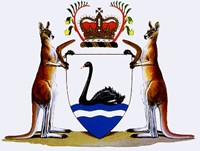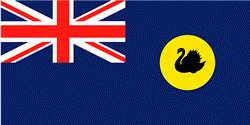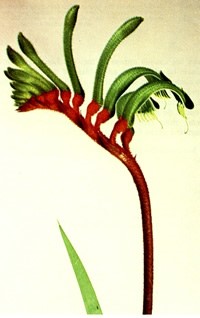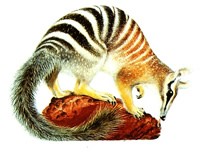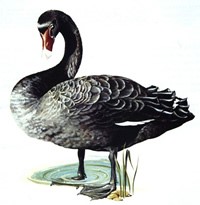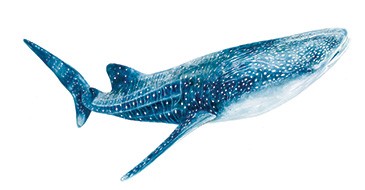This page includes information about the following emblems:
- Coat of Arms of Western Australia
- Flag of Western Australia
- Floral emblem
- Animal emblem
- Bird emblem
- Fossil emblem
- Marine animal emblem.
Coat of Arms of Western Australia
Show moreThe blazon of the Arms is as follows:
In heraldic terminology
For Arms: Argent on a base wavy Azure charged with a barrulet wavy Argent a Black Swan naiant proper.
And for Crest: On a Wreath Or and Sable The Royal Crown between two Kangaroo Paw (Anigosanthos Manglesii) flowers slipped proper.
And for Supporters: On either side a Kangaroo holding in the exterior fore-paw a Boomerang proper.
As the same are in the painting hereunto annexed more plainly depicted to be borne for Our said State on Seals, Shields, Banners, Flags, or Otherwise-according to the Laws of Arms.
In current terminology
For Arms: A silver shield with a base of rippled blue across, which is a thin wavy silver stripe. A black swan, in natural colour, and in horizontal position is floating on the blue base, which represents water.
And for Crest: Resting on a gold and black wreath is the Royal Crown between two Kangaroo Paw flowers accurately depicted.
And for Supporters: Two red kangaroos support the shield held between them. A boomerang accurately depicted is held by each in their other forepaw.The Coat of Arms is to be used on seals, shields, banners or otherwise according to the Laws of Arms.
Abbreviated Form: With the consent of the Garter Principal King of Arms, the Arms will be produced, for the use in Western Australia, in abbreviated form without the helmet and mantling. A helmet and mantling is depicted in correct heraldic form in the Warrant to conform to heraldic principles, but omission thereof for general usage is in line with the usage of the Commonwealth of Australia and of other Australian States.
Guidelines for use
For further information about using the State Coat of Arms please refer to Common Badging.
To obtain digital versions of the Coat of Arms, visit the Common Badging website - Downloads.
Bromides of the Coat of Arms (both forms) may be obtained from the State Law Publisher.
Flag of Western Australia
Show moreThe flag of the State of Western Australia is the British blue ensign, consisting of a blue flag with the Union flag occupying the upper quarter next to the Staff, differenced in the fly or half of the flag further from the Staff by the State Badge situated centrally in the fly.
History of the Flag
The Black Swan has been associated with WA since early settlement. Dutch explorer and navigator Captain Willem de Vlamingh, who encountered the Swan River in 1697, gave it the name due to the number of swans he saw there. And in the years after the foundation of the settlement, the areas of Perth and Fremantle were generally referred to as the Swan River Colony.
It is not surprising that the Black Swan should become the emblem of the State, though no record can be found of any early official pronouncement on the subject.
It was in use in the 1830s, only a few years after the establishment of the colony. It appears on bank notes issued in the early 1930s, and on the Swan River Guardian newspaper, first published in 1836. The Royal Arms, with the Swan below, appears at the head of the first issue of the Western Australian Government Gazette of 20 February 1836.
A design showing the Black Swan was selected for the first WA postage stamps, issued in 1854.
This same device was used on the Ordinances of Western Australia in 1858, and appears on reprints of earlier Acts which were made in that year.
On 17 August 1869, an Order in Council was issued authorising the Governors of Colonies to fly the Union Flag with the Arms or Badge of the Colony in the centre.
A circular from the Secretary of State notified the governors of this fact, and Frederick A. Weld, Governor of WA, in a despatch dated 3 January 1870, submitted a sketch of the badge which was proposed to be adopted. The sketch showed a black swan on a yellow background. He stated that: ‘This Colony at its commencement was usually known as the Swan River Settlement, and the Black Swan is represented upon its seal, and has always been considered as its special badge, or cognizance.’
The use of the badge was confirmed by a later Governor, William C. F. Robinson, in a despatch dated 27 November 1875.
Use of the badge of WA (on the Blue Ensign) began some time before 1870, following the Admiralty Letter of 16th January 1866 prescribing the use of a defaced Blue Ensign by vessels belonging to or permanently in the service of Colonial Governments.
In September 1912, when the Royal Warrant was issued granting Armorial Ensign and Supporters to the Commonwealth of Australia, the Black Swan was used as the emblem of WA.
Specifications of the Flag
For more information, see Specifications of the State Flag.
Floral emblem
Show moreThe striking flower of the Red and Green Kangaroo Paw, found naturally only in Western Australia, is the State's floral emblem.
Announcing the choice in November 1960, the then Premier of Western Australia, David Brand, said: ‘The Kangaroo Paw is so outstanding that it was the logical choice. It has grace and beauty, striking colour and distinctive outline, and it grows naturally only in Western Australia’.
It was considered that the emblem would heighten tourist interest in WA’s wildflowers and was recommended by Premier Brand on the advice of the State's Tourist Development Authority. It was subsequently incorporated into the State Coat of Arms.
The Red and Green Kangaroo Paw is one of eleven species of Anigozanthos, meaning ‘irregular flower’. It was named by botanist J.J.H. de Labillardiere who, as part of a French scientific expedition sheltered near Esperance on WA’s south coast in 1792, was the first European to collect the plant. The common name comes from the appearance of the unopened cluster of flowers that resembles the forepaw of a kangaroo.
From the early days of the Swan River Colony, botanists were intrigued by the unique plants of WA. With encouragement from government naturalist James Drummond, settlers sent seeds and specimens back to England. Prominent among these was the Red and Green Kangaroo Paw, which was introduced to England in 1833 and described in 1835 by a British botanist, David Don.
Several members of the Mangles family, including Ellen, the wife of the colony's first Governor, Captain James Stirling, were plant enthusiasts and promoted the cultivation of Swan River seeds in England. The family was honoured in an earlier name for this species - the Mangles Kangaroo Paw.
The Red and Green Kangaroo Paw is the best known and most famous of all the Kangaroo Paws. It is found in many areas of remnant bushland near Perth and is common in the sandy coastal plains of the State’s south-west.
This stunning plant has long flattened leaves at its base and brilliant red and green flowers that appear in spring and summer in fan-like clusters at the end of red felted stems. The sturdy metre-high stems provide a ready-made perch for honeyeaters or wattlebirds, which are often seen clinging to the stem, drinking nectar from each flower in turn and helping in pollination.
Animal emblem
Show moreOnce widespread across southern Australia, the Numbat has become extinct throughout most of its range and today survives only in small patches of forest in the south-west of Western Australia.
The destruction of habitat through clearing for farming and the introduction of foxes with European settlement led to the decline of the species.
While the Numbat is still endangered, listed as vulnerable, the outlook is gradually improving.
Following fox control, new populations have been established in nature reserves and forests. As part of its Native Species Breeding Program, the Perth Zoo is breeding Numbats for release into protected habitat. To date more than 60 Numbats have been released back into the wild.
The Numbat is a unique pouchless marsupial with a distinctive appearance.
It is a small animal with a slender body and reddish-brown coat with prominent white bands, and a long bushy tail. The adult Numbat is about 41 centimetres long (including the tail) and has a narrow, pointed snout and dark stripes across the eyes.
Its preferred habitat is woodland, with thick undergrowth littered with fallen branches. It shelters in hollow logs, trees and burrows and searches during daylight hours for termites. In the wild, the Numbat eats an exclusive diet of termites. Since the species is not strong enough to break into termite mounds, it waits until termites leave their nests and move underground to shallow feeding areas, or ‘galleries’. It uses sharp claws to dig insects out of logs and termite galleries, and its long tongue to flick the termites into its mouth. An adult consumes up to 20,000 termites a day, the equivalent of 10 per cent of its body weight.
Unlike most marsupials, the Numbat is active during the day, with its lifestyle closely linked to termite movements. In summer, termites are out early in the day and retreat deeper into the soil as the day becomes hot. Numbats also retreat in the heat, returning in the cool of the afternoon when termites are close to the surface again. In winter, the termites are inactive until late morning when the soil begins to warm, but they remain active until dusk.
The Numbat stays out at the same time to feed. It is basically a solitary animal, each with its own home range, the boundaries of which are fairly flexible. In summer, before the breeding season, the male Numbat roams a long way from its home range in search of females.
Four young are usually born between January and March. They are carried or nursed by the mother through winter. When they grow fur, they are placed in a small underground chamber lined with grass and leaves, at the end of a 1m to 2m long burrow, when their mother hunts for termites.
The young will play near the nest during her absence. They can fend for themselves by October and disperse by the end of the year.
The Numbat was proclaimed the animal emblem of Western Australia on 25 July 1973.
Bird emblem
Show moreAlthough the Black Swan is found in wetlands throughout Australia, this graceful bird has had a special association with WA from the earliest times. Aboriginal lore tells how ancestors of the Noongar people, the indigenous Australians living in the south west of the State, were once Black Swans who became men.
However, it was not until the voyages of Dutch explorers to the Great South Land in the 17th century that the existence of Black Swans was reported to the rest of the world. Until then, people in Europe believed that all swans were white.
In 1697, Dutch explorer and navigator Captain Willem de Vlamingh named the Swan River at the site of Western Australia’s capital city, Perth, after encountering flocks of Black Swans in the estuary. Some 130 years later, Captain James Stirling, investigating the area as a future British colony, also reported a flock of over 500 Black Swans flying over the river.
As a result, the original European settlement in WA was named the Swan River Settlement (or Colony) and the Black Swan became a recognised symbol of the new Colony, appearing on government papers, bank notes, postage stamps and other publications such as the Swan River Guardian.
The Black Swan was also used on the original State Crest prior to the granting of the Warrant for the State Coat of Arms. This Crest sometimes incorporated the motto: ‘Cygnis insignis,’ which means ‘noted for swans’. Subsequently the Black Swan was incorporated into the design of the State Badge, the State Seal, the State Coat of Arms and Commonwealth Coat of Arms.
The Black Swan was proclaimed the bird emblem of Western Australia on 25 July 1973.
The bird is similar in size and shape to the European species, but its plumage is black, often tinged with brown, and with white wing tips. The scientific name for the species ‘atratus’ means ‘dressed in black’. The beak is red with a white band near the tip.
A Black Swan stands at about 106–140cm with a wingspan of almost 2m. It ranges over wide expanses of fresh and salt water and builds a bulky nest in swamps and lakes.
Males and females are similar in size and appearance but males can be identified in flight by their larger neck and, when swimming, they hold their neck more erect. The female lays between four and eight eggs which take about 40 days to hatch. Both parents care for the young fluffy beige-grey swans, called cygnets. Black feathers start to appear on the young after about three to four weeks. Cygnets begin to fly at about two months of age but stay with the parents until the next breeding season. Swans mate for life, sometimes living 40 years.
Fossil emblem
Show moreThe initiative for WA to adopt a fossil emblem and for that emblem to be Mcnamaraspis kaprios came from pupils of Perth’s Sutherland Primary School in Dianella.
Following a school-initiated campaign in 1994, a State Fossil Emblem Committee was formed in 1995 to advise the then Minister for the Arts regarding appropriate fossil emblems for WA.
After public consultations and consideration of public submissions, the Gogo fish was recommended to Cabinet as the fossil emblem of WA and was proclaimed on 5 December 1995.
Marine animal emblem
Show moreIn the dappled light of the ocean, Rhincodon typus, the Whale Shark, can swim past almost unnoticed despite its size due to grey and yellow markings that act as camouflage. Much like a human finger print this pattern is unique to each animal. The markings and the shark’s large mouth, up to 1.5m wide, distinguish it as a striking inhabitant of the ocean.
The Whale Shark is in many ways an animal of contradictions. The largest fish, at up to 12m, it is a docile and gentle giant that eats the tiniest organisms of only millimetres in size. While it breathes through its gills like a shark, it filter-feeds like a whale by pulling plankton, krill and crustaceans through mesh-like screens in its gills.
Although it has thousands of tiny teeth in rows within its enormous mouth, it does not use them for feeding.
The species was identified and described in April 1828 by English doctor Andrew Smith, who was living in Cape Town and watched as fishermen harpooned the giant creature. Over the years, tall tales have been told about intrepid encounters on the sea with these enormous fish, with unconfirmed stories of Whale Sharks up to 20m long.
The species originated approximately 60 million years ago and represents a link to the prehistoric past. Whale Sharks live for 70 to 100 years and do not reproduce until they reach approximately 9m in length. It takes a Whale Shark pup up to 30 years to reach this size. Scientists in WA are working to discover more as much is still unknown about the Whale Shark.
Although they are found in tropical and warm oceans across the equator, Whale Sharks have become famous for gathering in Autumn and Winter in WA and have been seen as far south as the Kalbarri cliffs. Whale Sharks can dive to depths of 1286m but usually spend their time swimming and surface feeding. This makes WA one of the best places in the world to see them.
The Whale Shark was recommended as an emblem by the students of Forest Crescent Primary School following a State-wide competition. Whale Sharks are a vulnerable species and are protected in WA.
The Whale Shark was proclaimed the marine animal emblem of Western Australia on 12 November 2013.



